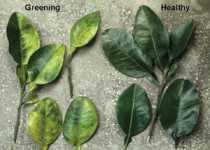Get A Grasp On Greening

Citrus production in Florida is one of the most important agricultural enterprises with a total value of $1.5 billion in production, and accounts for 71% of the total U.S. citrus production. The citrus industry, like most agricultural crops, battles an assortment of insect and disease pest infestations every year. Currently, citrus greening is a major concern to the citrus industry.
Citrus greening is caused by a phloem-limited bacterium (Candidatus Liberibacter). Currently, there are three known forms of the citrus greening bacterium: African (Candidatus L. africanus), Asian (Candidatus L. asiaticus), and American (Candidatus L. americanus). The bacterium found in Florida is the Asian form. The Asian form of citrus greening causes symptoms under both cool and warm (up to 35°C) temperature conditions. Currently, there are no known methods of control for this disease.
Citrus greening can infect nearly all citrus species, cultivars, and hybrids, as well as some citrus relatives. Sweet oranges, mandarins, and mandarin hybrids (tangelo) are highly susceptible to citrus greening. Lemons, grapefruit, pummelos, and sour orange also are affected and become non-productive when infected. Mexican lime, trifoliate orange, and some trifoliate orange hybrids are more tolerant and might show only some leaf symptoms. Citrus greening also can multiply in Chinese box orange and wood apple.
Disease Symptoms
Early disease symptoms of citrus greening may appear on a single shoot or branch as leaf yellowing, and the leaves may have a mottled or blotchy appearance. The disease also may cause small, narrow leaves and short stems that give plant growth a bunched appearance. Other symptoms include twig dieback, poor flowering, and stunted growth. Fruit from diseased trees is small and often misshapen. Typically, some green color remains even on ripe fruit. Affected fruit tastes bitter, medicinal, and sour. Seeds usually abort, and fruit set (formation) is poor. Symptoms vary according to time of infection, stage of the disease, tree species, and tree maturity.
Asian Citrus Psyllid
Citrus greening is transmitted by the insect vector Asian citrus psyllid (Diaphorina citri), and it is now well established in Florida. Injury caused by psyllids result from the sucking of large quantities of sap from the foliage (leaves), and transmission of the bacterium that cause greening disease. The adult female psyllids will lay their eggs on tips of growing shoots on and between unfurling leaves. The females may lay more than 800 eggs during their lifecycle. The eggs are 0.3 mm long, elongated, almond-shaped, thicker at base, and tapering toward distal end. Fresh eggs are pale, but then turn yellow and finally orange at time of hatching. Eggs are laid on plant tissue with long axis vertical to surface.
The psyllid nymphs pass through five instars. The nymphs are 0.25 mm long in first instar, 1.5 to 1.7 mm in last or fith instar. The nymphs are generally yellowish-orange in color with no abdominal spots. The wing pads are massive and the large filaments confined to the apical plate of abdomen. The nymphs are always found on new growth and move in a slow, steady manner when disturbed.
The adult psyllids are 3 to 4 mm long. The body is brown and mottled and the head is light brown. The forewing broadest apical half is mottled, and there is a brown band extending around the periphery of the outer half of the wing. The band is slightly interrupted near the apex. The antennae have a black tip and two small light brown spots on the middle segments. Living insects are covered with a whitish, waxy secretion, making them appear dusty.
The adults leap when disturbed and may fly a short distance. They usually are found in large numbers on the lower sides of the leaves with heads almost touching the surface and the body raised almost to a 30-degree angle. The period of greatest activity of the psyllid is during new growth of citrus.
Depending upon the season, the total life cycle of psyllids is usually 15 to 47 days. Adults generally live for several months. There is no diapause (a state of dormancy), but adult populations are generally low in winter (the dry season). There are 9 to 10 generations of the citrus psyllids in a year, however 16 generations also have also been observed in cages in the field.









